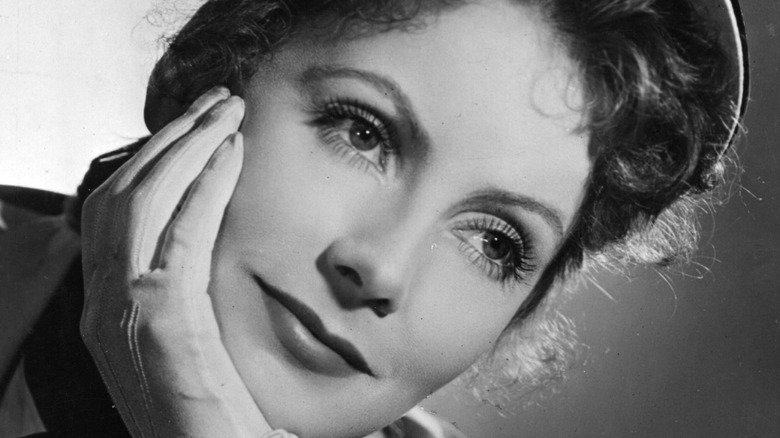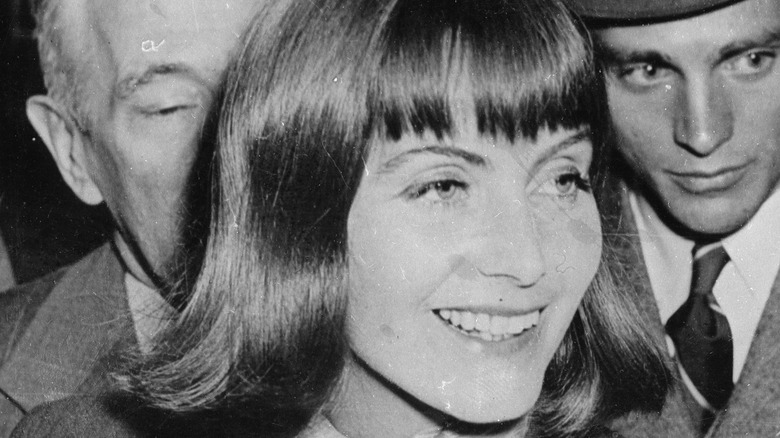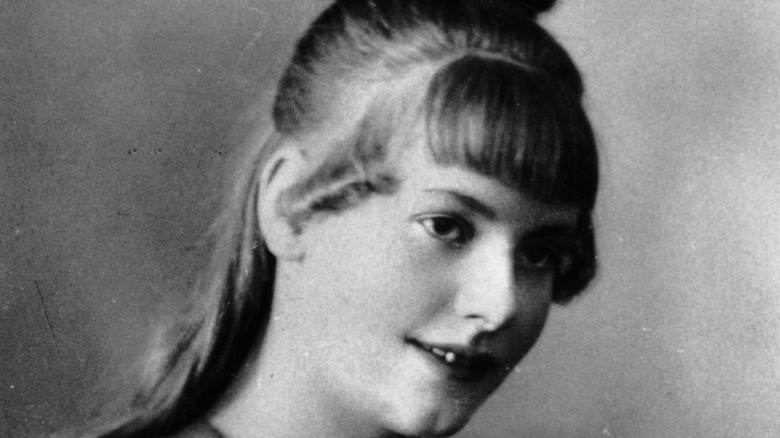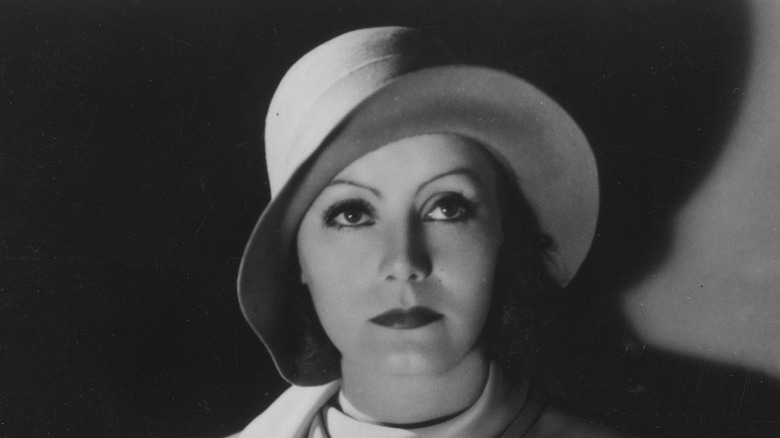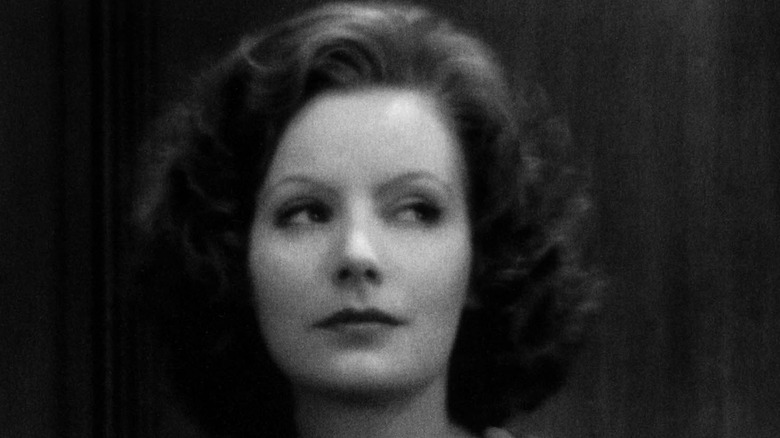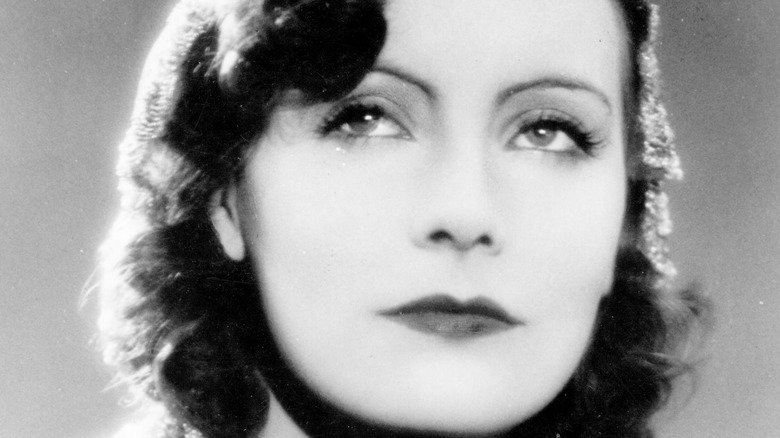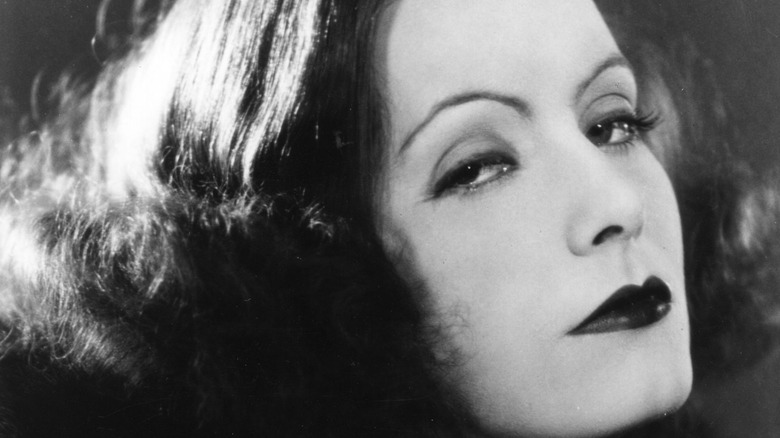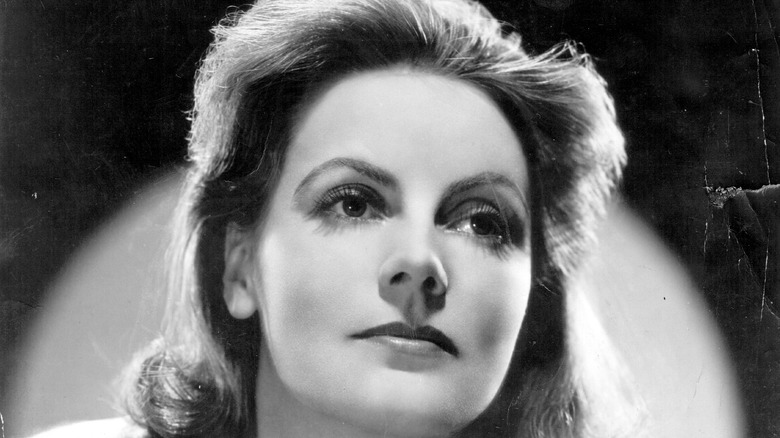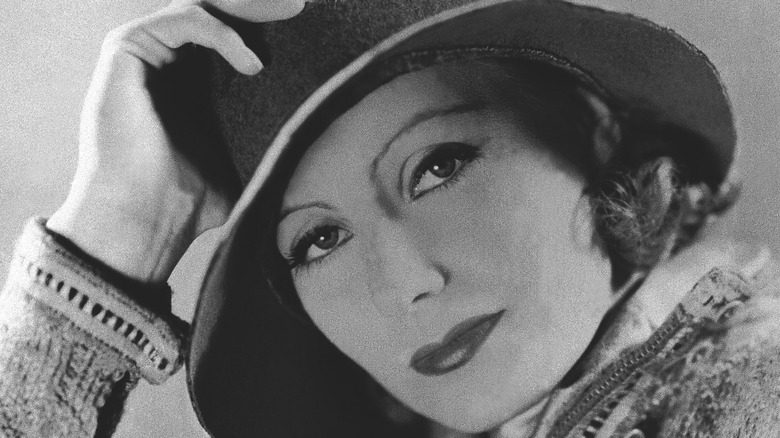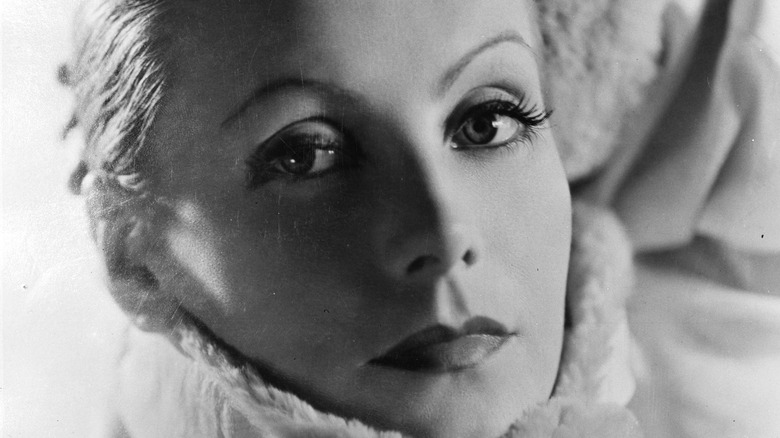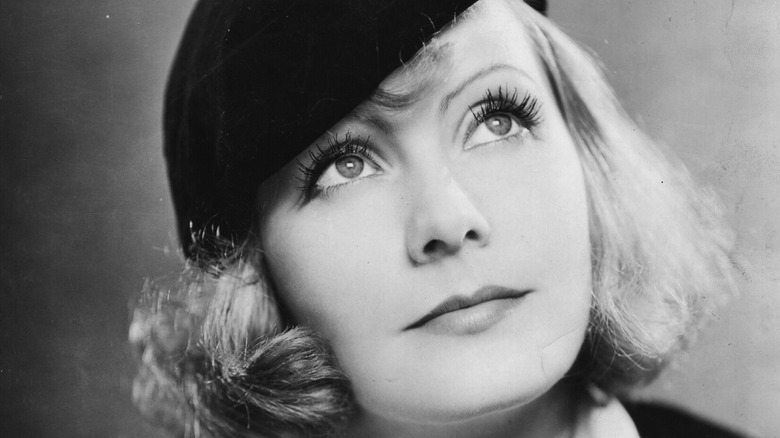What Greta Garbo's Private Life Was Really Like
"The Screen's First Lady," Greta Garbo mesmerized audiences with her seemingly effortless talent for on-camera acting (via the New York Times). Garbo rocked the American film industry in the 1920s and '30s, starring in unforgettable film classics such as "The Kiss" in 1929, "Anna Karenina" in 1935, and 1936's "Camille." Her life as a film star was filled with celebrity relationships, rumors, and gossip about her home life. Even as an international cinema legend, she would rarely talk to the press or show her face on any camera if not for the creation of a film. This unwillingness to share her private life with the public would later earn her the title of a "sphinx" in the New York Times Magazine.
Due to her elusive nature, Garbo's life as a celebrity unfolds to a modern reader as a mystery, pieced together by a letter here and a high-priority interview there. She once said this about her past: "I was born. I had a mother and father. I lived in a house. I went to school. What does it matter?" (via Biography). This comment oozes elusive cunning, and Garbo would go on to play this cat and mouse game of life facts with the press for over five decades. Who was Greta Garbo when she was alone? Where did this top celebrity call home? These are tough questions to answer. Luckily, there are in existence a few trustworthy accounts of Garbo before the big screen. It may shock some, but Greta Garbo's life before stardom was not all rainbows and movie sets. She suffered her list of hardsfmgmhips, instances which would mold her into the chimeric star she was.
Her Last Name Was Really Gustafsson
Greta Garbo was not a "Garbo" at all but a Gustafsson. She was given the name Greta Lovisa Gustafsson at her birth on September 18, 1905 (via Biography). Born to parents Karl and Anna Gustafsson in Stockholm, Sweden, the woman who would later become known as Greta Garbo entered the world as the last addition to an already filled household. Garbo's parents had two children by the time she was born, and the family's journey had only just begun.
The link to childhood completes a person. It's been said and is generally accepted that much of individual identity forms, or at least springs from, the challenges of childhood. According to Susan Ware in her book, "Notable American Women," Garbo's challenges were many. Karl Gustafsson, her father, was a lower-class working man. He is reported to have been ill very often and out of work, although some report his mysterious illnesses were connected to his proclivity for drinking, notes the New York Times. The mother, Anna Gustafsson, stayed at home with the three Gustafsson children. Although the star rarely spoke out about anything (past, present, or future), it is interesting to imagine Greta Garbo's life as an impoverished and struggling member of the lower class in Sweden. Any reasonable person would assume this upbringing took a toll on her mentally, if not physically, and the fact makes her success as an actress all the more heroic.
She Had to Leave School to Care for Her Father
Karl Gustafsson's bad health came to a peak in 1920 when he died after frequently being ill with kidney trouble, writes Barry Paris in "Garbo." This forced the teenage Greta Gustafsson to drop out of school and support her family full-time. With her father gone and her mother at home, the star-to-be started working to help feed her family. It's mentioned in the book "Notable American Women" that the young Gustafsson girl lathered heads in a salon and worked in a department store to earn money.
Things weren't always so bad for Greta Garbo. She grew up picking weeds and growing potatoes. Her father, at least according to "Garbo," kept a garden that gently jutted into Lake Årsta, which the family traveled to every week. After hours of work in the garden, with dirt under their fingernails and sweat on their brow, the Gustafsson children could cool off in the lake. Paris recounts another instance in that garden involving young Greta Gustafsson and a patch of strawberries. Apparently, the girl spent hours, sometimes all night, keeping her strawberries from some local boys so that she could sell them at the local market. This kind of silent determination and elusive attitude would go on to be the building blocks of her acting career.
She Began Acting as a Teen
Even as a young teen, Greta Garbo was interested in acting. This could have been, in part, due to her musical upbringing, as per "Garbo," by Barry Paris. Her childhood friends talked of her obsession with theater from an early age, as per Susan Ware in "Notable American Women," and Garbo herself mentioned the thrill of watching actors traffic in and out of a backstage door.
According to Paris' book, Garbo remembers sneaking to the local theater to catch a glimpse of backstage. She says, "At last [inside], I caught wonderful glimpses of the players at their entrances, and first smelled that most wonderful of all odors to a devotee of the theater — that backstage smell, compounded of grease-paint, powder, and musty scenery." She concludes the story with, "No odor in the world will ever mean as much to me. None!"
In 1922, Garbo met well-known producer-slash-director Erik Petschler and two actresses while working in a department store. The story goes that Garbo, unsure how to pitch herself to Petschler, got his phone number from one of the actresses with him and called him the next day. Apparently, she flat-out asked Petschler for a role in his film. He said yes. That film would be her first: "Peter the Tramp" from 1922.
From worshiper to worshiped, Garbo's acting career kicked off in 1922, when she enrolled in the Royal Dramatic Theater Academy. This is one of Sweden's most respected schools of acting, and Garbo had a scholarship, as per Biography. Though she was only there for about a year before quitting to act full time, Garbo would learn the foundations of her art at this school.
Greta Garbo had average interests outside of acting
Greta Garbo as an adolescent spoke of little other than her interest in performance, according to "Garbo," by Barry Paris. Apparently, Garbo was only interested in two things: being a fabulously famous movie star who never had to worry about money and being alone. Apart from this, Garbo led a perfectly average life. She was mundane in a brilliant way. Paris includes watching "Matlock" and "General Hospital" as her go-to pastime in later years.
Garbo also collected art and those pointy-haired, wrinkle-faced troll dolls that everyone seems to have had at some point in their lives. From all accounts, she was perfectly average in the way that she chose to spend her days. Celebrity or none, Garbo chose to be herself, and "being herself" meant wearing sensible footwear and acting entirely and heart-achingly pedestrian, so says the New York Times.
According to Garbo, she loved to "trudge about in a boy's coat and shoes and ride horseback [and] watch the sun set over the ocean," remarking that she was a tomboy at heart.
Because Greta Garbo was so reclusive and reluctant to speak with the press, not terribly much is known about her private life. Images, quotes, and friends' accounts can be clipped together to create an idea of the mysterious actress' life, but some details are speculation at best. Paris put it best when he wrote, "The stated goal of this search was not to knock Garbo off her pedestal but simply to climb up for a closer look. Yet when we get there she is gone."
She Only Wanted to be Let Alone
In Barry Paris' book, "Garbo," he lighlights Greta Garbo's love for solitude. "Even when I was a tiny girl I preferred being alone," says Garbo. In the book, the actress says she found out as a child that she could create wonderful worlds within her own imagination and rarely felt the urge to join any world outside those created by her mind's eye. This is the same actress who would later spout the most unforgettable line in Garbo history: "I want to be alone" (via TCM).
How long had she expected to be alone? Garbo's dating life wasn't very public, and she was never married despite several dalliances (via the New York Post). Actor-slash-soldier Gilbert Roland and Garbo had an affair, and allegedly Garbo left him her underwear before he shipped off to war. As the Los Angeles Times reports, those alleged panties from Roland's estate went up for auction in 1995. The Times also reports that letters also up for auction alluded to an intimacy between the Roland and Garbo, although the actress was known to be enigmatic and never claimed to know her purported lover.
She Kept Few Friends
Way back before she was Greta Garbo, her best friend from school, Elizabeth Malcolm, and she would sled down a local hill together after school, writes Barry Paris in his book, "Garbo." Malcolm says in the book that she remembers watching young Greta Gustafsson fly down the hill in her bright blue sled, her braided hair whipped straight back in the wind.
As an adult, Garbo's wish to be alone likely affected her friendships or was perhaps the reason for her lack thereof. According to the New York Times, Garbo couldn't accept positive attention, but, in spite of this, fell in love with herself. She treated her relationships like social obligations and, because of that, wanted few in her life.
Garbo also chose to spend most of her time with people less beautiful, talented, or powerful than she, once supposedly offering this as an explanation: "I often wondered why I was so successful with simple people ... and not with educated ones. I came up with a simple answer. I too was a simple, uneducated person." She wasn't uneducated, though. Despite all her humility, Greta Garbo was a talented actress who had been trained in her art. And, art or none, was unquestioningly worthy of any friendships she chose to pursue.
Her Best Friend was Mercedes de Acosta
The relationship between Greta Garbo and Mercedes de Acosta was one Garbo would hold on to even in her years of absolute stardom. De Acosta described Garbo as hauntingly beautiful and claimed to have been entranced the very first time she saw her (via "Garbo," by Barry Paris). But anyone with eyes and a brain can see how beautiful Garbo was by watching one of her films. What's more interesting is how De Acosta felt after having known Garbo.
The truth about this relationship may never be confirmed, but rumors of De Acosta's sexuality flooded the friendship at the time. De Acosta was once referred to as a "lesbian rake," as per the New York Post, which is unfair language even in the 1930s. The point is her friendship with De Acosta led many to wonder about the star's sexuality. Was she interested in men and women, and did she like men at all? After all, she never married. These were the whispers of the '30s, and they didn't end with the turn of the decade. Whatever her sexual preference, Garbo's relationship with De Acosta far surpassed any other acquaintance she had in duration and substance, and it served as a gentle insight into the star's true self.
Mauritz Stiller Loved Her After One Meeting
Nowadays, it seems like every new leading lady has a "discovery" story. It's as if a woman cannot be allowed, at least for legend's sake, to take credit for herself. Many such stories begin with a beautiful young woman with a dream and a particularly sparkly pair of eyes and end with a powerful man swooping in to refine the woman and give her a life of luxury. Greta Garbo's story fits this not-so-progressive mold perfectly. According to Barry Paris in his book, "Garbo," Swedish filmmaker Mauritz Stiller met Garbo in 1923, while she was enrolled in acting school, and he knew from the first screen test he wanted to help her become a star.
Legend has it (and so does the New York Times) that Stiller snatched the famous name "Garbo" from the Polish word "wygarbowac." The name is Stiller paying homage to himself. It's a term that refers to the refining of rough hide into smooth and expensive leather. Garbo's creation story is essentially Mauritz Stiller objectifying the woman. Roll the credits. The End. Except, Garbo does owe part of her success to Stiller. He taught her the art of the camera, how to act, and how to carry herself in keeping with her public persona. In the end, Stiller was her mentor and her connection to Metro-Goldwyn-Mayer (MGM), the company that would make her famous. That deserves recognition.
She was More Comfortable Talking to Cameras than People
Though she wanted to be famous, Greta Garbo had trouble talking to other people. Her wish to be alone extended further than the pull toward living inside her own head. Apparently, she was cripplingly shy, as noted by Barry Paris in "Garbo." Once she could find her light, though, the camera became the actress' best friend. It was dependable, direct, and ever-watching her: the best friend Garbo could ever ask for.
In addition to her shyness, Garbo had another hurdle in her ability to communicate with others. English, the predominately spoken language of MGM employees and prospective American interviewers, was not her first language. In fact, as Paris notes, the language barrier greatly contributed to Garbo's shyness.
On set, this posed no issues, as her first films were of the silent variety, but her luck would change when the "talkie" was created. "She was a shy person," said Clarence Brown, who directed Garbo in seven American films. "Her lack of English gave her a slight inferiority complex."
Biography notes MGM was reportedly not happy with her thick Swedish accent. But thanks to her hard work, dedication, and the luck of having a mentor, Garbo's enigmatic eyes, brow, lips, and cheeks became her way of expression. She could tell an epic tale with one glance, an admirable skill.
She Was Signed by MGM After One Audition
The story offered up in Barry Paris' "Garbo" of Greta Garbo's MGM journey begins with Louis Mayer, also known as the "Mayer" part of Metro-Goldwyn-Mayer. He happened to be in the right place at the right time. In 1924, Mayer was in Germany with his family and bumped into Mauritz Stiller and Garbo, who convinced him to see a private screening of a film she appeared in. Apparently, Meyer was obsessed with Garbo from the moment he saw her on-screen and would not stop talking about her, commenting that it was her eyes that sealed the deal.
Garbo, as described by Mayer's daughters during a meeting after the screening, was rather plain and certainly not the seductive figure known in Hollwyood. "We got in the elevator and this girl got on with us," Irene Mayer recalled. "Her black taffeta hat was not flattering ... the clothes didn't enhance her. ... She certainly didn't look like an actress." However, despite her appearance, she apparently held her own at dinner — "She was contained — charming, reasonably poised," said Irene. Louis Mayer was enthusiastic and immediately signed Garbo with MGM. This was the defining moment of her career, and the step that would transform her into a star.
